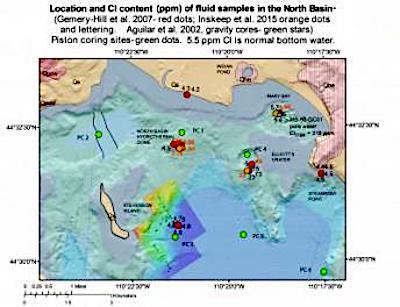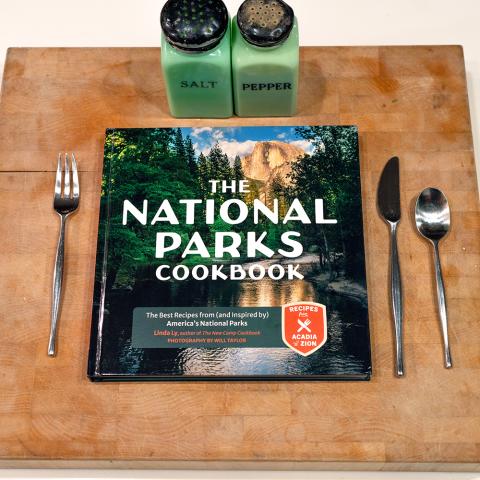
Editor's Note: Yellowstone Caldera Chronicles is a weekly column written by scientists and collaborators of the Yellowstone Volcano Observatory. This week's contribution is from geologist Pat Shanks, Scientist Emeritus with the U.S. Geological Survey.
When you think of a lake bed, what comes to mind? Squishy bottom with some grasses, rocks, and sunken logs? Well, the floor of Yellowstone Lake has hot springs, sinter deposits, altered muds, heat-loving bacteria, rocky siliceous spires, and hydrothermal explosion craters. These features have been the subject of intense study over the last 20 years, and research results show that the springs have an impact on the chemistry of the lake itself.
Yellowstone Lake is a large and pristine high-altitude fresh-water lake that is up to 130 m (430 ft) deep. The lake is irregular in shape covers an area roughly 27 km (16 mi) long (north-south) and 21 km (13 mi) wide (east-west). The northern half of the lake sits within the Yellowstone Caldera, which formed 631,000 years ago. The magma storage region several kilometers below the caldera provides heat that circulates the hot fluids that feed the lake-bottom hydrothermal features. Hot springs on the lake floor are typically in the 30-100°C (86-212°F) range, but boiling temperatures increase with depth due to increased pressure associated with the overlying water column. The maximum boiling temperature on the deepest part of the lake floor is about 180°C (356°F).

Map showing location of hot springs and chloride content of vent waters in the northern basin of Yellowstone Lake/USGS
To understand the contribution of hot springs to chemicals in the lake, a team of USGS and University of Wisconsin-Milwaukee scientists collected and analyzed water samples in 1998-2003 from streams flowing into the lake, from the water in the lake, and from hydrothermal vents. Calculations indicate that Yellowstone Lake water is substantially enriched in some elements compared to the stream waters that flow into the lake. This means lake-bottom hot springs substantially affect water chemistry
Studies by U.S. Geological Survey (USGS) scientists Bob Fournier and Irving Friedman and their associates have shown that the chloride concentration in water can be used to approximate the amount of heat being released from the Yellowstone volcanic system. By this criteria, Yellowstone Lake hosts the third largest thermal basin in the Park (the largest are the Upper and Lower Geyser Basins).
The hydrothermal fluids in Yellowstone's geyser basins and in Yellowstone Lake are mainly meteoric water (rain and snowfall) heated by deep circulation (several km/mi below ground) in hot rocky zones above the magma storage region. The fluids also include gases (like carbon dioxide and hydrogen sulfide) that are picked up from the magma. The ultimate chemistry of the fluids plays a major role in the variation we see in hot springs, geysers, mud pots, and fumaroles throughout the Park. For example, geysers usually form from very hot chloride-rich fluids, whereas mudpots form from steam vents where hydrogen sulfide reacts with oxygen to make sulfuric acid.
The effect of subsurface boiling as fluids rise to the Yellowstone Lake floor can be seen in chemical variations in hot springs. As hot fluids rise and pressure decreases, the steam separates from chloride-rich liquid. Steam may continue upward with the liquid, or it may find its own separate pathway to the surface.
Within Yellowstone Lake, hydrothermally active areas occur in the northern basin and in West Thumb, both of which are within the Yellowstone Caldera. Normal Yellowstone Lake water has a chloride content of 5.5 ppm (parts per million). Hot spring vents with lower chloride than 5.5 ppm represent steam vents, and hot springs with chloride higher than 5.5 ppm represent liquid-dominated vents. Variations in chloride at different vent areas show that some areas are steam dominated and others have a significant fraction of hydrothermal fluid.
Mapping of the composition of vents on the floor of Yellowstone Lake shows that different types of vents can be found together or separated. In the northern basin, most lake-bottom hot springs are dominated by steam, but chloride-rich fluids are found in the Mary Bay and Elliott's Crater hydrothermal explosion sites. In West Thumb basin, most fluids are chloride-rich, but steam-rich vents can be found in the shallower water around the basin's periphery.
Fully understanding how the hydrothermal systems function is a work in progress and has led, in part, to a large multidisciplinary project called Hydrothermal Dynamics of Yellowstone Lake (HD-YLAKE), funded largely by the National Science Foundation with additional support from the National Park Service and U.S. Geological Survey. HD-YLAKE is now in its third year of sampling and analysis, and exciting results will be coming out soon.




 Support Essential Coverage of Essential Places
Support Essential Coverage of Essential Places






